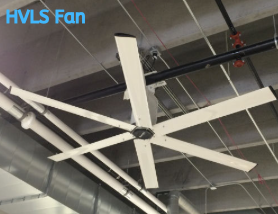By now, most of us have heard of HVLS style fan. Brands with big fancy names have been heavily marketing them as a solution for ventilating large spaces. While HVLS fans can be great additions to an existing ventilation system, there are some limitations and operating guidelines that need to be followed in order to maximize their benefit. In this blog, I’ll share what Eldridge has learned about how to make the most out of an investment in an HVLS fan.
HVLS Fan Basics
 High-volume low-speed fans are an evolution from the basic industrial ceiling fan. Inspired by airplane wings, HVLS fan blades have been specially designed to move large volumes of air evenly from the center hub all the way to the blade tip. Most manufacturers offer HVLS fan sizes ranging from 8’ to 24’ in diameter. Despite their large size, most HVLS fan motors are under 2 horsepower. That is why they are a cost effective way to move large volumes of air.
High-volume low-speed fans are an evolution from the basic industrial ceiling fan. Inspired by airplane wings, HVLS fan blades have been specially designed to move large volumes of air evenly from the center hub all the way to the blade tip. Most manufacturers offer HVLS fan sizes ranging from 8’ to 24’ in diameter. Despite their large size, most HVLS fan motors are under 2 horsepower. That is why they are a cost effective way to move large volumes of air.
Comfort Cooling in the Summer
When used to provide comfort cooling for people, an HVLS fan can reduce the perceived temperature by as much as 10 degrees F. This is because the air moving across a person’s skin evaporates sweat which causes adiabatic cooling. The velocity of the air determines how much adiabatic cooling occurs and how much cooling effect the person feels. HVLS fans are great for comfort cooling because they can move air at the right velocity to deliver the maximum adiabatic cooling effect over a large area.
There are some things to consider first before installing an HVLS fan for comfort cooling. First, in a non-air conditioned facility, the ventilation system must be sufficient to make the inside temperature the same as the outside temperature. The solar heat load on a building can cause it to be significantly hotter inside and this solar heat load must be removed before installing an HVLS fan. If not, the HVLS fan will be drawing the hottest air from the top of the building and blowing it down on the people below, essentially convection cooking them.
The second thing to consider is that because the HVLS fan provides a cooling effect and doesn’t actually change the air temperature, it should be located where its air movement can be felt. Therefore, to get the maximum benefit from an HVLS fan, the ideal location is where there is a high concentration of people.
Lastly, consider using spread and throw calculations to determine the best height for an HVLS fan to distribute air at the right velocity over the largest possible area. In my Spread and Throw blog on January 7, 2020, I provided the method and formulas for calculating spread and throw and how to use them to determine the proper placement of a comfort cooling fan.
Destratification in the Winter
The negative attribute of an HVLS fan to potentially convection cook people in the summer becomes a positive attribute in the winter. Because hot air will rise in a heated facility, the air at the top will be warmer than the air at floor level. This is referred to as air temperature stratification. An HVLS fan can effectively be used to move the hot air from the top of the building to floor level resulting in lower costs to heat a facility and greater comfort for people at floor level.
When using an HLVS fan to move hot air to floor level in the winter, the air velocity should be lower than the summertime velocity. This is to reduce the potential for inducing adiabatic cooling which would offset the benefit of moving the warm air to floor level. Therefore, select an HVLS fan that has variable speed settings or is compatible with a VFD to reduce the fan speed in the winter.
Conclusion
Properly selecting and locating an HVLS for your application can make it a great addition to your existing ventilation system. The benefits of higher productivity from workers in the summer and lower heating costs in the winter will provide a quick payback for your investment. If you are not sure which HVLS fans are right for your application, call a ventilation expert at Eldridge and we will help you create a successful environment in your facility.
